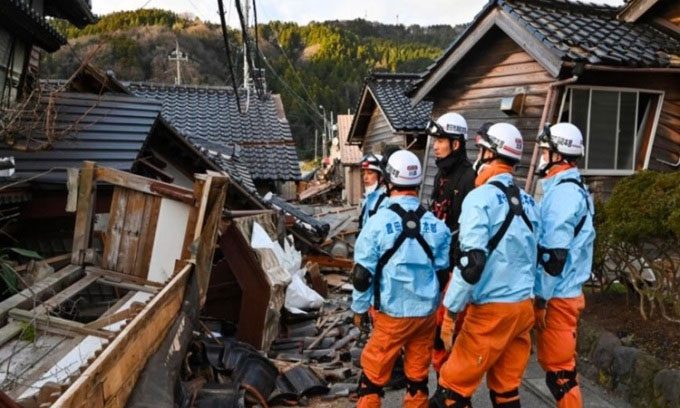Japan is renowned as one of the most disaster-prepared nations in the world, thanks to its earthquake-resistant building regulations, largely based on past experiences.
Three days after a major earthquake shook the western coastal region of Japan, the search for survivors is still ongoing. The 7.6 magnitude earthquake off the Noto Peninsula created the strongest tremors in the area in decades, prompting authorities to evacuate nearly 100,000 people to avoid a tsunami. While the damage assessment process is not yet complete, initial reports estimate that hundreds of homes were destroyed by the quake and subsequent fires, with over 80 confirmed fatalities to date, according to National Geographic.
However, geologist Lucy Jones believes that the intensity and offshore location of the earthquake could have caused much greater damage had Japan been less prepared. According to Jones, Japan’s strict building regulations resulted in significantly less damage than anticipated. Japan is one of the most seismically active countries in the world, situated at the convergence of four tectonic plates, which means earthquakes occur frequently. Although often undetected by those on the surface, tremors happen daily in Japan. According to the EarthScope Consortium, the country experiences around 1,500 notable earthquakes each year. Due to this risk, finding ways to coexist with earthquakes has become an essential part of Japanese communities.

Firefighters inspect collapsed wooden houses in Wajima city on the Noto Peninsula, the area most heavily affected by the earthquake earlier this year. (Photo: AFP).
Adapting to Major Earthquakes
Understanding how to best prepare for major earthquakes is the result of extensive efforts, rooted in lessons learned from past disasters, according to Keith Porter, chief engineer at the Institute for Catastrophic Risk Reduction in Canada. In Japan, earthquake-resistant building regulations were first established after the 7.9 magnitude earthquake in 1923, which killed over 140,000 people and reduced hundreds of thousands of structures to rubble. These early regulations focused on reinforcing newly constructed buildings in urban areas while neglecting wooden and concrete homes.
Earthquake-resistant building regulations have undergone several significant changes over the decades since then, most notably the Building Standards Law of 1950 and the revised earthquake-resistant standards of 1981. Not only do these laws provide detailed construction standards, but they also specify the criteria that buildings must meet during an earthquake. The 1950 act stipulated that buildings should withstand a 7.0 magnitude earthquake without serious issues. The 1981 amendments specified that when a 7.0 magnitude earthquake occurs, a building should only sustain minor damage and remain operational. For stronger earthquakes, Japanese law requires that buildings must not collapse.
In other words, when experiencing strong earthquakes like the event at the beginning of 2024, “a building is considered successful if it does not collapse and cause fatalities, even if the damage is extensive enough to be irreparable,” Porter explains. Similar standards exist in North America, focusing on saving lives rather than the long-term sturdiness of structures.
Designing for Tremors
There are various techniques employed to meet the above construction standards in Japan. The choice of which technique to use often depends on the type of structure, such as skyscrapers or single-family homes, as well as available funding and other considerations. At a basic level, buildings are reinforced with beams, columns, and thicker walls to better withstand shaking.
Many techniques also help separate the building from the ground’s shaking motion. A common method is to install a cushioning layer made from good shock-absorbing materials like rubber at the base of the building’s foundation, reducing the impact of ground motion on the structure. Another method, called damping systems, involves constructing the entire structure on a thick cushion to create a complete separation between the building and the shifting ground.
However, specific challenges arise depending on the location of the building, such as being in a floodplain, where the soil may not be able to support the weight of the structure. Additionally, consequences following a major earthquake, such as fires or damage from tsunamis, also contribute to the destruction of homes. That is why building safety regulations are only part of Japan’s overall strategy for living with earthquakes. After the recent earthquake, Professor Toshitaka Katada from the University of Tokyo expressed confidence that “no people anywhere on Earth are as prepared for disasters as the Japanese,” considering the regular preparedness measures taken domestically, such as planning and evacuation drills. Evacuation centers, such as schools or public places, are equipped with emergency supplies. Japan also has an effective warning system for both earthquakes and tsunami threats.
Koichi Kusunoki, a professor at the Earthquake Research Institute at the University of Tokyo, stated that he and his colleagues are conducting field surveys along the Noto Peninsula to gain a better understanding of the impacts of the major earthquake. This research could be the first step toward understanding how to keep people safer in the next earthquake.




















































